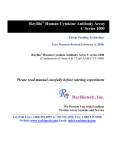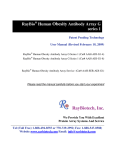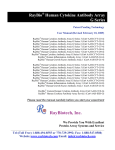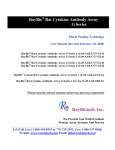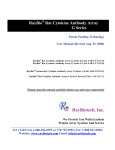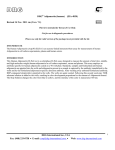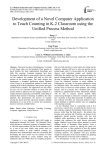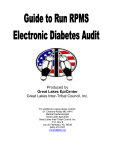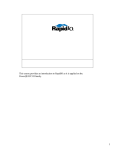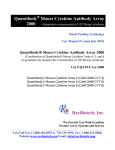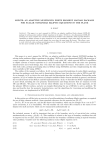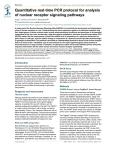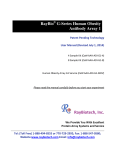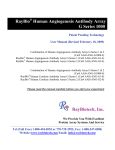Download RayBiotech, Inc.
Transcript
RayBio® Human Adipokine Antibody Array G series 1 Patent Pending Technology User Manual (Revised February 18, 2009) RayBio® Human Adipokine Antibody Array G Series 1 (Cat# AAH-ADI-G1-4) RayBio® Human Adipokine Antibody Array G Series 1 (Cat# AAH-ADI-G1-8) RayBio® Human Adipokine Antibody Array Service (Cat# AAH-SER-ADI-G1) Please read the manual carefully before you start your experiment RayBiotech, Inc. We Provide You With Excellent Protein Array Systems And Service Tel:(Toll Free) 1-888-494-8555 or 770-729-2992; Fax: 1-888-547-0580; Website:www.raybiotech.com Email: [email protected] RayBiotech, Inc. RayBio® Human Adipokine Antibody Array G Series 1 Protocol TABLE OF CONTENTS I. Introduction……..……………………………... 2 How It Works………………………..………… 6 Materials Provided…………………………….. 7 Additional Materials Required………………… 7 III. Overview and General Considerations………… 8 A. Preparation of Samples……………………… 8 B. Handling Glass Chips ………………………. 9 C. Incubation…………………………………… 9 IV. Protocol………………………………………… 9 A. Blocking and Incubation……………………. 9 B. Detection……………………………………. 12 Interpretation of Results……………………….. 12 VI. Troubleshooting Guide………………………… 19 VII. Selected References Using RayBiotech Arrays 19 II. V. Cytokine Antibody Arrays are RayBiotech patent-pending technology. RayBio® is the trademark of RayBiotech, Inc. RayBio® Human adipokine Antibody Array G series 1 I. Introduction All cell functions, including cell proliferation, cell death and differentiation, as well as maintenance of health status and development of disease, are controlled by many genes and signaling pathways. New techniques such as cDNA microarrays have enabled us to analyze the global gene expression 1-3. However, almost all cell functions are executed by proteins, which cannot be studied by DNA and RNA alone. Experimental analysis clearly shows a disparity between the relative expression levels of mRNA and their corresponding proteins 4. Therefore, it is critical to analyze the protein profile. Currently, two-dimensional polyacrylamide SDS page coupled with mass spectrometry is the mainstream approach to analyzing multiple protein expression levels 5,6. However, the requirement of sophisticated devices and the lack of quantitative measurements greatly limit its broad application. Thus, no simple, cost effective, and rapid method of analysis of multiple protein expression levels has been available to researchers until now. Our RayBio® Human Cytokine Antibody Array is the first commercially available protein array system 7-11. By using the RayBiotech system, scientists can rapidly and accurately identify the expression profiles of multiple cytokines in several hours inexpensively. The RayBiotech kit (G series) is a glass slide format. The kit provides a highly sensitive approach to simultaneously detect multiple cytokine expression levels from cell culture supernatant, patient’s serum, tissue lysate and other sources. The arrays are manufactured using non-contact arrayer. The experimental procedure is simple and can be performed in any laboratory. The signals from G series arrays are detected using a laser scanner. Besides the products listed in this manual, RayBiotech also provides RayBio® Human Cytokine Antibody Array G series 1000 for detection of 120 human cytokines in single experiment, RayBio® Human Cytokine Antibody Array G series 2000 for detection of 174 human cytokines in single experiment and RayBio® Human Cytokine Antibody Array G series 4000 for detection of 274 human cytokines in single experiment. RayBio® Human adipokine Antibody Array G series 2 Pathway-specific array systems allow investigators to focus on the specific problem and are becoming an increasingly powerful tool in cDNA microarray system. RayBiotech’s first protein array system, known as RayBio® Human Adipokine Antibody Array, is particularly useful compared with the human adipokine cDNA microarray system. Besides the ability to detect protein expression, RayBiotech’s system is a more accurate reflection of active adipokine levels because it only detects secreted adipokines, and no amplification step is needed. Furthermore, it is much simpler, faster, environmentally friendlier, and more sensitive. Simultaneous detection of multiple adipokines undoubtedly provides a powerful tool to study obesity. The area of obesity research is getting hotter ever over the past years. One of the key driving factor is that adipose tissue is found no longer to be an inert energy storage organ, but is emerging as an active participant in regulating physiological and pathologic processes. Many soluble factors have been identified from the adipose tissue and are so called as adipocytokines or adipokines. But adipokines are also expressed in a number of other tissues and organs. Because all of these factors can act in an autocrine, paracrine and endocrine manner in the organisms, adipokines are thought to serve as mediators linking obesity, inflammation, immunity and other obesity related diseases 12-15. Without doubt, simultaneous detection of multiple adipokines provides a powerful tool to study adipokines. References: 1. LPS induces the interaction of a transcription factor, LPS-induced TNF-a factor, and STAT6(B) with effects on multiple cytokines. Xiaoren Tang, Deborah Levy Marciano, Susan E. Leeman and Salomon Amar. PNAS. April 5, 2005 vol. 102 no. 14 5132-5137 2. HIV-1-mediated apoptosis of neuronal cells: Proximal molecular mechanisms of HIV-1-induced encephalopathy. Yan Xu, Joseph Kulkoshy, Roger j. Pomerantz. PNAS. 2004 May 4, 2004 Vol. 101 No. 18. RayBio® Human adipokine Antibody Array G series 3 3. Synergistic increases in intracellular Ca(2+), and the release of MCP-1, RANTES, and IL-6 by astrocytes treated with opiates and HIV-1 Tat. GLIA. 2005 Apr 15;50(2):91-106. 4. Bone Marrow Stroma Influences Transforming Growth Factor-β Production in Breast Cancer Cells to Regulate c-myc Activation of the Preprotachykinin-I Gene in Breast Cancer Cells. Hyun S. Oh, Anabella Moharita… Pranela Rameshwar. CANCER RESEARCH. 64, 6327-6336, September 1, 2004 5. Recombinant Herpes Simplex Virus Type 1 (HSV-1) Codelivering Interleukin12p35 as a Molecular Adjuvant Enhances the Protective Immune Response against Ocular HSV-1 Challenge JOURNAL OF VIROLOGY. Mar. 2005 Vol. 79, No. 6. 6. Dysregulated Inflammatory Response to Candida albicans in a C5-Deficient Mouse Strain. Alaka Mullick, Miria Elias, Serge Picard, Philippe Gros. Infection and Immunity, Oct. 2004, p. 5868-5876, DOI: 10.1128/IAI.72.10.5868-5876.2004 7. Leukotriene B4 Strongly Increases Monocyte Chemoattractant Protein-1 in Human Monocytes Li Huang, Annie Zhao, Frederick Wong, Julia M. Ayala, Jisong Cui Arteriosclerosis, Thrombosis, and Vascular Biology. 2004;24:17831788 8. Human CD1d-unrestricted NKT cells release chemokines upon Fas engagement. Martin Giroux and François Denis. Yan Xu, Joseph Kulkoshy, Roger j. Pomerantz. Blood. prepublished online September 2, 2004; DOI 10.1182/blood2004-04-1537 9. Monitoring the response of orthotopic bladder tumors to granulocyte macrophage colony-stimulating factor therapy using the prostate-specific antigen gene as a reporter. Wu Q, Esuvaranathan K, Mahendran R. Clinical Cancer Research. 2004 Oct 15; 10(20):6977-84. 10. Neuroglial activation and neuroinflammation in the brain of patients with autism (p NA). Diana L. Vargas, Caterina Nascimbene, Chitra Krishnan, Andrew W. Zimmerman, Carlos A. Pardo. Annals of Neurology. 2005 Jan 1; DOI: 10.1002/ana.20315 11. Cytokine profiling of macrophages exposed to Porphyromonas gingivalis, its LPS or its FimA. Qingde Zhou, Tesfahun Desta, Dana T. Graves and Salomon Amar. Infection and Immunity (IAI). 2005 Feb;73(2):935-43. RayBio® Human adipokine Antibody Array G series 4 12. Veto-like activity of mesenchymal stem cells: functional discrimination between cellular responses to alloantigens and recall antigens. Rameshwar P. Journal of Immunology. 2003 Oct 1;171(7):3426-34. 13. Cytokine responses elicited in endothelial cells after treatment with a specific toxin. Jaya Pandey. BioCompare Product Review. May 13, 2004 14. Proteomic Characterization of the Interstitial Fluid Perfusing the Breast Tumor Microenvironment. A Novel Resource for Biomarker and Therapeutic Target Discovery. Julio E. Celis, Pavel Gromov, Teresa Cabezón, José M. A. Moreira, Noona Ambartsumian, Kerstin Sandelin, Fritz Rank, and Irina Gromova. Molecular Cellular Proteomics. April 2004; 11(3):328-39. 15. Increased Expression and Secretion of Interleukin-6 in Patients with Barrett’s Esophagus.. Katerina Dvorakova, Harinder Garewal Clinical Cancer Research. 2004 Mar 15;10(6):2020-8. 16. Antibody array-generated profiles of cytokine release from THP-1 leukemic monocytes exposed to different amphotericin B formulations. Turtinen LW, Prall DN, Bremer LA, Nauss RE, Hartsel SC. Antimicrobial Agents Chemotherapy. 2004 Feb;48(2):396-403. 17. The promise of cytokine antibody arrays in drug discovery process. R.-P. Huang, W. Yang, D. Yang, L. Flowers, I. R. Horowitz, X. Cao and R. Huang. Expert opinion on drug discovery. (2005) 9:601-615. RayBio® Human adipokine Antibody Array G series 5 Here’s how it works Array support Sample Incubation of Sample With arrayed antibody Supports Cocktail of Biotin-Ab Incubation with Biotinylated Ab 1-2 hrs 1-2 hrs Labeled – streptavidin Incubation with Labeled- streptavidin 2 hrs Detection of signals Data analysis and graph RayBio® Human adipokine Antibody Array G series 6 II. Materials Provided Upon receipt, all components of the RayBio® Human Adipokine Antibody Array kit should be stored at -20°C. At -20°C the kit will retain complete activity for up to 6 months. Once thawed, the glass chips, Fluorescent dyestreptavidin, internal control and 2X Blocking Buffer should be kept at – 20°C and all other component should be stored at 4°C. Use within three months after reagents have been thawed. Please use within six months of purchase. • RayBio® Human Adipokine Antibody Microarray slides (4 or 8 subarrays in each glass chip) • Biotin-Conjugated Anti-Adipokines (1 or 2 tubes, 1 tube/ 4 subarrays) • 1,500X Fluorescent Dye-conjugated Streptavidin (Cy3 equivalent, 1 tube) • 2X Blocking Buffer (5 ml) • 20X Wash Buffer I (30 ml) • 20X Wash Buffer II (30 ml) • Internal control (powder, 1 tube) • 2X Cell Lysis Buffer (10 ml) • RayBio® G series antibody array accessory (including slide incubation chamber, Gasket, Protective cover, Snap-on sides and adhesive film) • 30 ml tube • Manual Additional Materials Required • • • • • Orbital shaker Laser scanner for fluorescence detection Aluminum foil Distilled water Plastic box RayBio® Human adipokine Antibody Array G series 7 Layout of G series Antibody Array Antibody Array Blank Blank Barcode Barcode 8 arrays in one glass chip 4 arrays in one glass chip III. Overview and General Considerations A. Preparation of Samples • Use serum-free conditioned media if possible. • If serum-containing conditioned media is required, use uncultured media as a negative control sample, since many types of sera contain cytokines. • For cell lysates and tissue lysates, we recommend using RayBio® Cell Lysis Buffer to extract proteins from cell or tissue (e.g. using homogenizer). Dilute 2X RayBio® Cell Lysis Buffer with H2O (we recommend adding proteinase inhibitors to Cell Lysis Buffer before use). After extraction, spin the sample down and save the supernatant for your experiment. Determine protein concentration. • We recommend using: o 50–100 µl of Conditioned media (undiluted), or o 50–100 µl of 2-fold to 5-fold diluted sera or plasma, or o 10–200 µg of total protein for cell lysates and tissue lysates. B. Handling glass chips • The microarray slides are sensitive, do not touch the surface. Grip the slides by the edges only. • Handle all buffers and slides with powder-free gloves. • Avoid breaking glass slide. • Handle glass chip in clean environment. RayBio® Human adipokine Antibody Array G series 8 C. Incubation • Completely cover array area with sample or buffer during incubation, and cover the incubation chamber with adhesive film or plastic sheet protector to avoid drying. • Avoid foaming during incubation steps. • Perform all incubation and wash steps under gentle rotation. • Cover the incubation chamber with adhesive film during incubation, particularly when incubation is more than 2 hours or 50 µl of sample or reagent is used. • Avoid cross-contamination from overflowing solution to neighboring wells. • Several incubation steps such as step 3 (blocking), step 4 (sample incubation), step 9 (biotin-Ab incubation) or step 12 (Fluorescent dyestreptavidin incubation) may be done at 4°C for overnight. Please make sure to cover the incubation chamber tightly to prevent evaporation. IV. Protocol A. Blocking and Incubation 1. Take the glass chip out from the box. Let air dry for 2 hours. 2. Assemble the glass chip into incubation chamber and incubation frame as shown below. (Note: if you slide has be assembled, you can go to step 3 directly). RayBio® Human adipokine Antibody Array G series 9 3. Add 100 µl 1 X Blocking Buffer into each well and incubate at room temperature for 30 min to block slides. Dilute 2X Blocking Buffer with H2O. Make sure no bubbles are in the well. Note: only add reagents to wells printed with antibodies. 4. Decant Blocking Buffer from each well, and incubate arrays with sample at room temperature for 1 to 2 hours. Dilute sample using 1X Blocking Buffer if necessary. We strongly recommend including Internal Control in your assay, add 100 µl of Blocking Buffer to IC tube, mix well and transfer 1 µl of IC to each well (50 to 100 µl of sample). Note: when transfer IC, use 0.1 µl to 2 µl pipettor. Note: Incubation may be done at 4°C for overnight. Note: We recommend using 50 to 100 µl of undiluted conditioned media or 50 to 100 µl of original or 2-5 fold diluted serum or plasma or 10-200 ug of protein for cell lysates and tissue lysates. Dilute the lysate at least 10 fold with 1X blocking buffer to make a total volume of 50 to 100 µl. Make sure there are no bubbles in the wells. RayBio® Human adipokine Antibody Array G series 10 Note: The amount of sample used depends on the abundance of adipokines. More of the sample can be used if signals are too weak. If signals are too strong, the sample can be diluted further. 5. Decant the samples from each well, and wash 3 times with 150 µl of 1X Wash Buffer I at room temperature with gentle shaking. 2 min per wash. Dilute 20X Wash Buffer I with H2O. Completely remove wash buffer I in each wash step. Note: avoid solution flowing into neighboring wells. 6. Put the glass chip with frame into a box with 1X Wash Buffer I (cover the whole glass slide and frame with Wash Buffer I), and wash 2 times at room temperature with gentle shaking for 10 min each. 7. Decant the 1X Wash Buffer I from each well, Put the glass chip with frame into the box with 1XWash Buffer II (cover the whole glass slide and frame with Wash Buffer II), and wash 2 times at room temperature with gentle shaking for 5 min. Remove all of Wash Buffer II in the well. Dilute 20X Wash Buffer II with H2O. 8. Prepare working solution for biotin-conjugated antibodies. After brief spinning, add 300 µl µl of 1x blocking buffer to the BiotinConjugated Antibody tube. Mix gently. Note: the diluted biotin-conjugated antibodies can be stored at 4°C for 2-3 days. 9. Add 70 µl of diluted biotin-conjugated antibodies to each corresponding well. Incubate at room temperature for 2 hours. Note: incubation may be done at 4°C for overnight. 10. Wash as directed in steps 5 and then wash 3 times with 150 µl of 1X Wash Buffer II at room temperature with shaking. 2 min per wash. Completely remove wash buffer II in each wash step. 11. Add 70 µl of 1,500 fold diluted Fluorescent dye-conjugated streptavidin (after brief spinning, add 1.5 ml of Blocking Buffer to Fluorescent dye-conjugated streptavidin tube) to each subarray. Cover RayBio® Human adipokine Antibody Array G series 11 the incubation chamber with adhesive film. Cover the plate with aluminum foil to avoid exposure to light or incubate in dark room. 12. Incubate at room temperature for 1 to 2 hours. Note: incubation may be done at 4°C for overnight. 13. Wash with Wash Buffer I twice as directed in steps 5. B. Fluorescence Detection 1. Decant excess Wash Buffer from wells. 2. Disassemble the slide out of the incubation frame and chamber. 3. Place the whole slide in 30 ml centrifuge tube provided, add enough Wash Buffer I (about 20 ml) to cover the whole slide and gently shake at room temperature for 10 minutes. Decant Wash Buffer I. Repeat Wash Buffer I once. Wash with Wash Buffer II (about 20 ml) with gentle shake at room temperature for 10 minutes. Or wash using slide chamber. Rinse the slide with distilled H2O. 4. Remove water droplets by centrifuge at 1,000 rpm for 3 minutes and then let slide dry completely in air at least 20 minutes (protect from light). Make sure the slides are absolutely dry before the scanning procedure. 5. Image the signals using laser scanner such as Axon GenePix using cy3 or “green” channel (Excitation frequency 532 nm). Note: we recommend scanning slides right after experiment. You also can store the slide at –20°C in dark for several days. If you do not have a laser scanner, we can provide service for you. Just simply send your slide to us and we will take care of it. V. Interpretation of Results: RayBio® Human adipokine Antibody Array G series 12 The following figure shows RayBio® Human Cytokine Antibody Array G series 2000 probed with different cell culture supernatant. The images were captured using laser scanner. The biotin-conjugated protein produces positive signals, which can be used to identify the orientation and to compare the relative expression levels among the different wells. The internal control (IC) can also be used to normalize the signal intensities among array membranes in different experiments. The signal intensities obtained from laser scanner can simply be imported into our analysis tool. The analysis tool will help you: • • • • • • • Locate your signal intensities to antibody array map Link the protein to website for more detailed information on the particular protein Protein list sorting Average signal intensities Subtract background Normalize the data from different samples Obtain protein level comparison charts among different samples This analysis tool is very simple and affordable, which will not only assist in compiling and organizing your data, but also reduces your calculations to a “copy and paste” step. If you do not use our RayBio® Analysis Tool, you can locate the cytokines by referring to corresponding RayBio® Human cytokine Antibody Array G series map. Normalization and comparison RayBio® Human adipokine Antibody Array G series 13 For biomarker discovery or for analysis of large number of arrays, great attention must be paid to the normalization. Our antibody array design includes several controls for normalization and comparison of arrays performing in different membranes and different experiments (for more information please read the reference 17). Positive control. Positive control is biotinylated protein. It can be used to normalize the streptavidin incubation step. If the positive signals from different array membranes are similar, positive control is a simple and effective way for normalization. Internal control. RayBio® antibody arrays also include spiking-in protein serving as internal control (IC). The spiking-in proteins do not have crossreactivity with protein in the array. It can be used to normalize the entire process. Negative control. Negative control is BSA. Normally, it should only give a background reading. Data Extraction Tips: • Ignore any comet tails • Define the area for signal capture for all spots as 110-120 micron diameter, using the same area for every spot. • Use median signal value, not the total or the mean • Use local background correction (also median value). • Exclude obvious outlier data in its calculations. • Scan all slides at same PMT Using these guidelines, along with using PMT, brightness and contrast settings that reduce the background as much as possible, we get very good results with interassay and intraassay CV <20%, even with some imperfections in the antibody spots. Threshold of significant difference in expression: Any ≥1.5-fold increase or ≤0.65-fold decrease in signal intensity for a single analyte between samples, provided that both signals are well above background (Mean background + 2 standard deviations, accuracy ≈ 95%). RayBio® Human adipokine Antibody Array G series 14 RayBio® Human Adipokine Antibody Arrays 1 (for simultaneous detection of 62 human adipokines) 1 2 3 4 5 6 7 8 9 10 11 12 13 14 a POS 1 POS 2 POS 3 NEG 4-1BB ACE-2 Acrp30 Adipsin AgRP Angiopoietin-1 Angiopoietin-2 ANGPTL4 CRP ENA-78 b POS 1 POS 2 POS 3 NEG 4-1BB ACE-2 Acrp30 Adipsin AgRP Angiopoietin-1 Angiopoietin-2 ANGPTL4 CRP ENA-78 FGF-6 Growth Hormone HCC-4 IFN-gamma IGFBP-1 IGFBP-2 IGFBP-3 IGF-I IGF-I sR IL-1 alpha IL-1 beta IL-1 sRI IL-1 R4/ST2 HCC-4 IFN-gamma IGFBP-1 IGFBP-2 IGFBP-3 IGF-I IGF-I sR IL-1 alpha IL-1 beta IL-1 sRI IL-1 R4/ST2 MCP-3 c Fas d Fas FGF-6 Growth Hormone e IL-6 IL-6 sR IL-8 IL-10 IL-11 IL-12 Insulin IP-10 Leptin Leptin R LIF Lymphotactin MCP-1 f IL-6 IL-6 sR IL-8 IL-10 IL-11 IL-12 Insulin IP-10 Leptin Leptin R LIF Lymphotactin MCP-1 MCP-3 g MCSF MIF MIP-1beta MSP alpha OPG OSM PAI-I PARC PDGF-AA PDGF-AB PDGF-BB RANTES Resistin Serum Amyloid A h MCSF MIF MIP-1beta MSP alpha OPG OSM PAI-I PARC PDGF-AA PDGF-AB PDGF-BB RANTES Resistin Serum Amyloid A i SDF-1 sTNF RI sTNF RII TECK TGF-beta TIMP-1 TIMP-2 TNF-alpha VEGF XEDAR IC 1 IC 2 IC 3 NEG j SDF-1 sTNF RI sTNF RII TECK TGF-beta TIMP-1 TIMP-2 TNF-alpha VEGF XEDAR IC 1 IC-2 IC 3 NEG We also offer Custom Human Cytokine Antibody Arrays. You can select the cytokines of interest from the following list and we will produce the customized array at an affordable price. For more information, please visit our website, www.raybiotech.com. Note: IL-12 reacts both IL-12p40 and IL-12p70. IL-12p70 only recognizes IL-12p70. Abbreviations: IP-10, Interferon-inducible protein-10; LAP, latency associated peptide (TGF-β1); LIF, leukocyte inhibitory factor. MMP, Matrix Metalloproteinase; Pos, positive control; Neg, negative control. All other are used standard abbreviations. RayBio® Human adipokine Antibody Array G series 15 Human Custom Antibody Array List (285 proteins) 4-1BB/TNFRSF9 CNTF GDNF IL-18 R alpha MIP-1 alpha SCF ACE-2 Cripto-1 GITR IL-18 R beta MIP-1 beta SCF R Activin A CRP GITR Ligand IL-1ra MIP-1 delta SDF-1 alpha Adiponectin/Acrp30 CTACK/CCL27 GM-CSF IL-2 MIP-3 alpha SDF-1 beta Adipsin/Factor D CTLA-4 GRO IL-2 R alpha MIP-3 beta sgp130 AFP CXCL16 GRO-a IL-2 R beta MMP-1 Shh N AgRP(ART) DAN Growth Hormom IL-2 R gamma MMP-2 Siglec-5 ALCAM Decorin HB-EGF IL-21 R MMP-3 Siglec-9 Angiogenin DKK-1 HCC-4/CCL16 IL-22 MMP-7 sTNF RII Angiopoietin-1 DKK-3 hCGa, intact IL-28A/IFN-lambda MMP-8 sTNT RI Angiopoietin-2 DKK-4 HGF IL29/IFN-lambda 1 MMP-9 TACE Angiostatin DPPIV/CD26 HVEM IL-3 MMP-10 TARC ANGPTL4 DR6 I-309 IL-31 MMP-13 TECK/CCL25 AR (amphiregulin) Dtk ICAM-1 IL-4 MPIF-1 TGF-alpha Axl E-Cadherin ICAM-2 IL-5 MSP a Chain TGF-beta 1 B7-1(CD80) EDA-A2 ICAM-3 IL-5 R alpha NAP-2 TGF-beta 2 Bate2 M EGF IFN-gamma IL-6 NCAM-1 TGF-beta 3 BCAM EGF R IGFBP-1 IL-6 sR NGF R Thyroglobulin BCMA/TNFRSF17 EG-VEGF/PK1 IGFBP-2 IL-7 Nidogen-1/Entactin Tie-1 BDNF ENA-78 IGFBP-3 IL-8 NrCAM Tie-2 beta IG-H3 Endoglin IGFBP-4 IL-9 NRG1-beta 1/HRG1-beta 1 TIM-1 Betacellulin (BTC) Endostatin IGFBP-5 IL-9 R NT-3 TIMP-1 bFGF Eotaxin IGFBP-6 Insulin NT-4 TIMP-2 BLC Eotaxin-2 IGF-I IP-10 Oncostatin M TIMP-4 BMP-4 Eotaxin-3 IGF-I sR I-TAC/CXCL11 Osteopontin TNF-alpha BMP-5 EpCAM/TROP1 IGF-II LAP(TGF-b1) Osteoprotegerin TNF-beta BMP-6 ErbB2 IL-1 alpha Leptin R PAI-I TPO BMP-7 ErbB3 IL-1 beta LEPTIN(OB) PARC TRAIL R1 b-NGF Erythropoietin R (EPO R) IL-1 R4/ST2 LH P-Cadherin TRAIL R2 BTC E-Selectin IL-1 sRI LIF PDGF R alpha TRAIL R3 CA125 Fas Ligand IL-1 sRII LIGHT PDGF R beta TRAIL R4 CA15-3 Fas/TNFRSF6 IL-10 LIMPII/SR-B2 PDGF-AA Trappin-2/Elafin TREM-1 CA19-9 Fcr RIIB/C IL-10 R alpha Lipocalin-2/NGAL PDGF-AB Carbonic Anhydrase IX(CA9) Ferritin IL-10 R beta L-Selectin PDGF-BB TROY Cardiotrophin-1 (CT-1) FGF-4 IL-11 Lymphotactin PECAM-1 TSH Cathepsin S FGF-6 IL-12 p40 LYVE-1 Platelet Factor 4 TSLP CCL14a/HCC-1 FGF-7 IL-12 p70 Marapsin/Pancreasin PlGF u PAR CCL21/6ckine FGF-9 IL-13 MCP-1 Procalcitonin/Calcitonin Ubiquitin+1 CCL28/VIC FLRG IL-13 Ra1 MCP-2 Prolactin VCAM-1 CD14 Flt-3 Ligand IL-13 Ra2 MCP-3 PSA-free VE-Cadherin CD23/Fc epsilon RII Follistatin IL-15 MCP-4 PSA-total VEGF CD27 Fractalkine IL-16 MCSF P-selectin VEGF R2 CD30 FSH IL-17 M-CSF R RAGE VEGF R3 CD40 Furin IL-17B MDC RANK VEGF-C CD40 Ligand Galectin-7 IL-17C MICA RANTES VEGF-D CEA GCP-2 IL-17F MICB Resistin CEACAM-1 GCSF IL-17R MIF S-100b CK beta 8-1 GDF-15/MIC-1 IL-18 BPa MIG SAA RayBio® Human adipokine Antibody Array G series 16 RayBiotech, Inc., the protein array pioneer company, strives to research and develop new products to meet demands of the biomedical community. RayBio’s patent-pending technology allows detection of 274 cytokines, chemokines and other proteins in a single experiment. Our format is simple, sensitive, reliable and cost effective. Products include: Cytokine Arrays, Chemokine Arrays, ELISA kits, Phosphotyrosine kits, EIA kits, Recombinant Proteins, Antibodies, and custom services. 1. Antibody arrays 2. Cytokine antibody array Human cytokine antibody arrays Mouse cytokine antibody arrays Rat cytokine antibody arrays Pathway- or disease-focused antibody arrays Inflammation antibody array Angiogensis antibody array Chemokine antibody array Growth factor antibody array MMP antibody array Atherosclerosis antibody array Adipokine antibody arrays Antibody analysis tool, software 3. 4. 5. 6. 7. 8. 9. ELISA Cell-based phosphorylation assay Custom antibody arrays Antibody Recombinant protein Cytokine protein arrays Quantibody arrays for quantitative measurement of cytokine and other protein concentration. 10. Phosphorylation antibody arrays 11. Biotin label-based antibody arrays for high density antibody arrays 12. EIA 13. Peptide RayBiotech also provides excellent custom service: 1. Antibody arrays 2. Protein arrays RayBio® Human adipokine Antibody Array G series 17 3. 4. 5. 6. 7. 8. 9. Peptide synthesis Production of recombinant protein and antibody Peptide arrays Phosphorylation arrays ELISA EIA Assay development Just simply send your samples and we will do the assay for you. Technology transfer program Have you developed technologies or reagents interested to the scientific and research community? RayBiotech can help you commercialize your technologies, reagents and dream. RayBio® Human adipokine Antibody Array G series 18 VI. Troubleshooting guide Problem Weak signal High background Cause Recommendation Inadequate detection Check laser power and PMT parameters Inadequate reagent volumes or improper dilution Check pipetters and ensure correct preparation Short incubation times Ensure sufficient incubation Time and change sample incubation step to overnight Too low protein concentration in sample Don’t make too low dilution Or concentrate sample Improper storage of kit Store kit at suggested temperature Make sure correct amount of antibodies Excess of biotinylated antibodies Excess of streptavidin Make sure correct amount of streptavidin Inadequate detection Check laser power And PMT parameters dust Work in clean environment Increase wash time and use more wash buffer Insufficient wash Uneven signal Bubbles formed during incubation Avoid bubble formation during incubation Arrays are not completed Covered by reagent Completely cover arrays with solution VII. Selected References Using RayBiotech Arrays: 1. Protein Array Reveals Differentially Expressed Proteins in Subcutaneous Adipose Tissue in Obesity. Škopková M, Penesová A, Sell H, Rádiková Z, et al. Obesity. 2007;15:2396-2406. RayBio® Human adipokine Antibody Array G series 19 2. Adipokines oversecreted by omental adipose tissue in human obesity. Maury E, Ehala-Aleksejev K, Guiot Y, Detry R, Vandenhooft A, Brichard SM. Am J Physiol Endocrinol Metab. 2007; 293:E656-E665. 3. Atrial natriuretic peptide inhibits the production of adipokines and cytokines linked to inflammation and insulin resistance in human subcutaneous adipose tissue. Moro C, Klimeakova E, Lolmede K, Berlan M, et al. Diabetologia. 2007; 50:1038-1047. 4. Adipokine protein expression pattern in growth hormone deficiency predisposes to the increased fat cell size and the whole body metabolic derangements. Ukropec J, Penesova A, Skopkova M, Pura M, et al. J Clin Endocrinol Metab. 2008;93:2255-2262. 5. Cytokine secretion by human adipocytes is differentially regulated by adiponectin, AICAR, and troglitazone. Sell H, Dietze-Schroeder D, Eckardt K, Ecker J. Biochem Biophys Res Comm. 2006: 343(3):700-706. 6. Plasma, urine, and renal expression of adiponectin in human systemic lupus erythematosus. Rovin BH, Song H, Hebert LA, Nadasdy T, et al. Kidney International. 2005;68:1825-1833. 7. Adiponectin and functional adiponectin receptor 1 are expressed in airway epithelial cells in Chronic Obstructive Pulmonary Disease. Miller M, Cho JY, Pham A, Ramsdell J, Broide DH. J Immunol. 2009;182:684-691. 8. Sell H, Dietze-Schroeder D, Kaiser U, Eckel J. MCP-1 is a potential player in the negative crosstalk between adipose tissue and skeletal muscle. Endocrinol. 2005;147:(5):2458-2467. 9. Autocrine Action of Adiponectin on Human Fat Cells Prevents the Release of Insulin Resistance-Inducing Factors. Dietze-Schroeder D, Sell H, Uhlig M, Koenen M, Eckel J. Diabetes. 2005;54:2003-2011. 10. Leptin-mediated cytokine release and migration of eosinophils: Implications for immunopathophysiology of allergic inflammation. Wong CK, Cheung PFY, Lam CWK. Eur J Immunol. 2007;37:2337-2348. 11. Diet-induced adiposity alters the serum profile of inflammation in C57BL/6N mice as measured by antibody array. Fenton JI, Nuñez NO, Yakar S, Perkins SN, et al. Diabetes Obesity Metab. http://dx.doi.org/10.1111/j.14631326.2008.00974.x RayBio® Human adipokine Antibody Array G series 20 Note: RayBio® is the trademark of RayBiotech, Inc. Cytokine protein arrays are RayBiotech patent-pending technology. This product is intended for research only and is not to be used for clinical diagnosis. Our produces may not be resold, modified for resale, or used to manufacture commercial products without written approval by RayBiotech, Inc. Under no circumstances shall RayBiotech be liable for any damages arising out of the use of the materials. Products are guaranteed for three months from the date of purchase when handled and stored properly. In the event of any defect in quality or merchantability, RayBiotech’s liability to buyer for any claim relating to products shall be limited to replacement or refund of the purchase price. HiLytePlus™ is a trademark of AnaSpec, Inc. This product is for research use only. ©2008 RayBiotech, Inc. RayBio® Human adipokine Antibody Array G series 21























